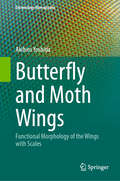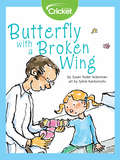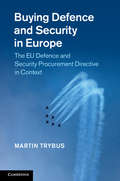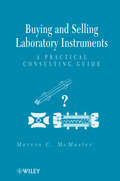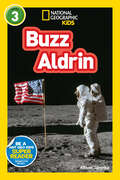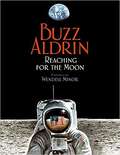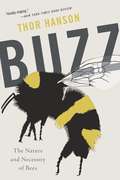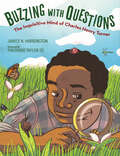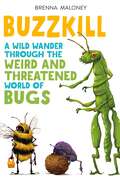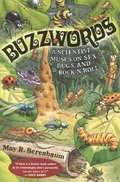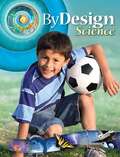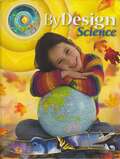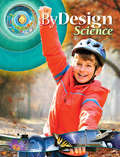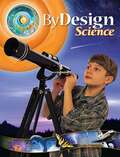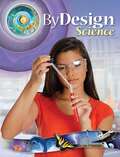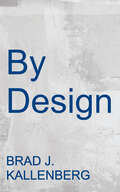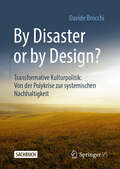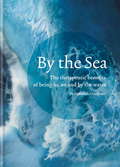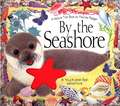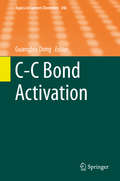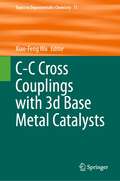- Table View
- List View
Butterfly and Moth Wings: Functional Morphology of the Wings with Scales (Entomology Monographs)
by Akihiro YoshidaThis book explores the various functions of butterfly and moth wings. Lepidoptera wings are covered with variously colored scales and exhibit a wide variety of color patterns, with some functioning as significant signals in behavior. They are also the flight organs, as the wings of the other insects are. Although research on Lepidopteran wings has predominantly focused on the color patterns and flight performance, they have many other functions that contribute to their lives. Chapters in this book examine airflow regulation, behavioral signal sending, friction reduction, sensory signal reception, pheromone secretion, antireflection, and high hydrophobicity. Utilizing the perspectives from biology, physics, chemistry, and mathematics, the author explores the functions, structures, construction, and development of these functional wings. Since many of the wing functions are attributed to or assisted by the scale functions, an understanding of the scale functions is necessary to understand the wing functions. The book includes chapters on the marginal scale morphology and function of the small moth wing, as well as the development of the wing with scales. Programmed cell death, which plays a crucial role in the development of the functional wing, is also described. The extensive descriptions offer new insights into Lepidoptera wings and may inspire ingenious devices from a physics and engineering perspective. In particular, the physiological approach to the wing mechanoreception in this book is the first for butterfly and moth wings to thoroughly investigate their intricate mechanisms. With numerous figures to aid the understanding of readers, the book will appeal to researchers and graduate students interested in entomology, biomimetics and physics.
Butterfly with a Broken Wing
by Susan Yoder AckermanWhen Ella tries to fly like a butterfly, she ends up with an injury to her arm.
Buying Defence and Security in Europe
by Martin TrybusBuying Defence and Security in Europe is the first critical evaluation of the EU Defence and Security Procurement Directive 2009/81/EC, which is now the basis for public and private entities buying armaments and sensitive goods and services in the EU. This instrument aims to ensure non-discrimination, competition and transparency in the security sectors. Part one provides a critical analysis of the economical, historical, political, military-strategic and legal contexts of the new EU Defence and Security Procurement Directive. Part two covers the main aspects of the Directive: its scope, procedures, security of supply and information, offsets and subcontracting, and finally its review and remedies system. This book is an essential overview of a legislative milestone in the field.
Buying and Selling Laboratory Instruments
by Marvin C. McmasterA time-tested, systematic approach to the buying and selling of complex research instruments Searching for the best laboratory instruments and systems can be a daunting and expensive task. A poorly selected instrument can dramatically affect results produced and indirectly affect research papers, the quality of student training, and an investigator's chances for advancement. Buying and Selling Laboratory Instruments offers the valuable insights of an analytical chemist and consultant with over four decades of experience in locating instruments based upon both need and price. It helps all decision makers find the best equipment, service, and support while avoiding the brand-loyalty bias of sales representatives so you can fully meet your laboratory's requirements. The first section of the book guides buyers through the hurdles of funding, purchasing, and acquiring best-fit instruments at the least-expensive price. It explains how to find vendors that support their customers with both knowledgeable service and application support. Also offered is guidance on adapting your existing instruments to new applications, integrating new equipment, and what to do with instruments that can no longer serve in research mode. The second section explains the sales process in detail. This is provided both as a warning against manipulative sales reps and as a guide to making the sale a win-win process for you and your vendor. It also shows you how to select a knowledgeable technical guru to help determine the exact system configuration you need and where to find the best price for it. Added bonuses are summary figures of buying sequence and sales tools and an appendix containing frequently asked questions and memory aids. Buying and Selling Laboratory Instruments is for people directly involved in selecting and buying instruments for operational laboratories, from the principle investigator to the person actually delegated with investigating and selecting the system to be acquired. Sales representatives; laboratory managers; universities; pharmaceutical, biotech, and forensic research firms; corporate laboratories; graduate and postdoctoral students; and principle investigators will not want to be without this indispensible guide.
Buzz (Insomniacs #05)
by S. R. MartinFrom the warped mind of S. R. Martin comes the story of a kitchen appliance gone berserk. One stormy night, a girl and her baby-sitter watch in amazement as the Slice 'n' Dicer gets zapped by lightning. Suddenly, the machine has a mind of its own, and it's after them!
Buzz Aldrin (Readers)
by Kitson JaznykaBlast off and experience humankind's first steps on the moon in this new biography about Buzz Aldrin. You'll learn about astronaut Aldrin's life -- his childhood, his work on NASA's Apollo 11 mission, and his dream to get humans to Mars.This biography tells a true hero's story. In addition to running text about his remarkable life and achievements, readers will find fun facts, quotes from Aldrin, and lots of amazing photographs. It's sure to captivate kids interested in history, famous people, and space exploration. National Geographic Readers' expert-vetted text, along with brilliant images and a fun approach to reading have proved to be a winning formula with kids, parents and educators. Level 3 text provides accessible yet wide-ranging information for kids reading on their own. Each reader includes text written by an experienced, skilled children's book author, a photo glossary, and interactive features in which kids get to reinforce what they've learned in the book.This biography is timed to release in advance of the 50th anniversary of Apollo 11 and Buzz Aldrin's historic expedition.
Buzz: The Nature and Necessity of Bees
by Thor HansonFrom the award-winning author of The Triumph of Seeds and Feathers, a natural and cultural history of the buzzing wee beasties that make the world go round.Bees are like oxygen: ubiquitous, essential, and, for the most part, unseen. While we might overlook them, they lie at the heart of relationships that bind the human and natural worlds. In Buzz, the beloved Thor Hanson takes us on a journey that begins 125 million years ago, when a wasp first dared to feed pollen to its young. From honeybees and bumbles to lesser-known diggers, miners, leafcutters, and masons, bees have long been central to our harvests, our mythologies, and our very existence. They've given us sweetness and light, the beauty of flowers, and as much as a third of the foodstuffs we eat. And, alarmingly, they are at risk of disappearing.As informative and enchanting as the waggle dance of a honeybee, Buzz shows us why all bees are wonders to celebrate and protect. Read this book and you'll never overlook them again.
Buzzing with Questions: The Inquisitive Mind of Charles Henry Turner
by Janice N. HarringtonThe story of Charles Henry Turner, the first Black entomologist — a scientist who studies bugs — is told in this fascinating book for young readers.Can spiders learn? How do ants find their way home? Can bugs see color? All of these questions buzzed endlessly in Charles Henry Turner&’s mind. He was fascinated by plants and animals and bugs. And even when he faced racial prejudice, Turner did not stop wondering. He constantly read, researched, and experimented. Author Janice Harrington and artist Theodore Taylor III capture the life of this inspiring scientist and educator in this nonfiction picture book, highlighting Turner's unstoppable quest for knowledge and his passion for science. The extensive back matter includes an author's note, time line, bibliography, source notes, and archival images.A NSTA/CBC Best STEM Book
Buzzkill: A Wild Wander Through the Weird and Threatened World of Bugs
by Brenna MaloneyThe praying mantis is the only animal on Earth with one ear—and it’s in the middle of its chest. Aphids are born pregnant. Moths can’t fly during an earthquake. If you didn’t know these things, you soon will. Packed full of jaw-dropping facts, Buzzkill presents the big picture on bugs. You might think ew, gross. Insects are icky. Or scary. Or dangerous. They can be. But there’s so much more you need to know.Insects play a critical role on our planet, from sustenance to pollination to medicines and more. Brenna Maloney tackles both the wacky and weird, as well as threats to insects and their habitats, their possible extinction, and ways that everyday people, like you, can prevent their decline.Find out what all the buzz is about!Godwin BooksA JUNIOR LIBRARY GUILD GOLD STANDARD TITLE
Buzzwords: A Scientist Muses On Sex, Bugs, And Rock 'n' Roll
by May R. BerenbaumWhat sort of person devotes their life to the study of bugs? How do you picture your average, every-day entomologist? "I've been photographed on several occasions," writes author May Berenbaum, "and it seems that every time, photographers ask me to pose in one of three ways: seated in front of a microscope, with an insect (usually a cockroach) on my face, or with an insect net clutched in my hand."In Buzzwords, Berenbaum expertly blows away these stereotypes with short takes on all things entomological--from the story of a pet ant kept for 14 years to major motion pictures featuring cockroaches.Buzzwords showcases the Best of Berenbaum, a selection from her humor column in the American Entomologist professional journal, accompanied by a number of original pieces written for this book. "I know people are reading these columns," she notes, "because they write me letters that point out all the mistakes I've made!"The book comes in four parts: How entomologists see insects, including their view of a U.S. government plan to eradicate illicit coca fields by dropping caterpillars from airplanes.How the rest of the world sees insects, with Berenbaum's proposed classificatory scheme for placing Spider Man, Firefly, and other cartoon superheroes into well-defined taxa.How entomologists view themselves--featuring Bambi Berenbaum, a gorgeous entomologist created for an episode of TV's popular "The X-Files," whose character was inspired when the scriptwriter consulted Berenbaum's books.How entomologists see their colleagues, with various views on scholarly citation, motion sickness, and more. Along the way are some thought-provoking observations--for example, about the impact of television on public knowledge of science. In one poll, Berenbaum writes, 35% of adults said they believed that prehistoric humans coexisted with dinosaurs, a la the Flintstones.Berenbaum even takes on the controversy over alternative medicine, fearlessly purchasing Chinese medicinal insects during a professional trip to Vancouver, which also happened to be her honeymoon. "Okay, so maybe giving two talks at an International Congress of Entomology is not everybody's idea of a romantic honeymoon venue, but it seemed like a good idea at the time."Berenbaum is a noted scientist in a field that doesn't always gets the respect it deserves, but she shows us that there's a fun and even freaky side of life with insects. While working on the University of Illinois' annual Insect Fear Film Festival she received a letter from a "crush freak" who waxed lyrical about a young, sexy babe with a size 9 or 10 shoe. Berenbaum writes, "On the one hand, it's almost gratifying to think that insect pest management can arouse people's interest to such an extreme extent. On the other hand, it has convinced me not to list my shoe size in the biographical sketch of my next book."Readers will appreciate learning how the word "shloop" was introduced to the medical literature when physicians used a metal suction tip to remove a cockroach from a patient's ear canal, and how one investigator named a series of subspecies bobana, cocana, dodana, and so forth, "anticipating by 60 years the song, 'The Name Game,' by Shirley Ellis."Although you'll chuckle all the way, Berenbaum has the last laugh, giving powerful lessons in the spectacular diversity of the insect world and the nature of scientific discovery, cleverly packaged as witty observations on subjects far and wide.If you're a scientist or you like reading about science--better yet, if you've ever found a fly in your soup (or worried that you might have unknowingly just slurped one down with your tomato bisque--this book is for you.
By Design Grade 2 Student Edition
by BY DESIGN ROYALTY ESCROW ACCOUNTBy Design Grade 2 Student Edition
By Design Grade 3 Student Edition
by BY DESIGN ROYALTY ESCROW ACCOUNTBy Design Grade 3 Student Edition
By Design Grade 7 Student Edition
by BY DESIGN ROYALTY ESCROW ACCOUNTBy Design Grade 7 Student Edition
By Design Science: Grade 8 Student Edition
by BY DESIGN ROYALTY ESCROW ACCOUNTBy Design Grade 8 Student Edition
By Design: Ethics, Theology, and the Practice of Engineering
by Brad J. KallenbergBoth engineering and human living take place in a messy world, one chock full of unknowns and contingencies. "Design reasoning" is the way engineers cope with real-world contingency. Because of the messiness, books about engineering design cannot have "ideal solutions" printed in the back in the same way that mathematics textbooks can. Design reasoning does not produce a single, ideally correct answer to a given problem but rather generates a wide variety of rival solutions that vie against each other for their relative level of "satisfactoriness," a reasoning process analogous to design is needed in ethics. <p><p>Since the realm of interpersonal relations is itself a fluid and highly contingent real-world affair, design reasoning offers the promise of a useful paradigm for ethical reasoning. This volume undertakes two tasks. First, it employs design reasoning to illustrate how technological artifacts can be assessed for their inherent moral properties. Second, it uses the design paradigm as a means for bringing engineering ethics into conversation with Christian theology in order to show how each can be for the other a catalyst for the revolutionary task of living by design.
By Disaster or by Design?: Transformative Kulturpolitik: Von der Polykrise zur systemischen Nachhaltigkeit
by Davide BrocchiJede große Transformation in der Geschichte der Menschheit wurde bisher von einer kulturellen Revolution ausgelöst und begleitet. Diese Publikation zeigt, warum dies auch für die Transformation zur Nachhaltigkeit gilt. Im Fokus stehen nicht nur Werte, Menschen- und Naturbilder, sondern auch die gesellschaftliche Verantwortung von Bildung, Wissenschaft, Kunst und Medien. Für die zweite Auflage wurden die Inhalte überarbeitet und aktualisiert, Thesen geschärft und neue Studien einbezogen.Gegenwärtig befinden wir uns zwischen zwei großen gesellschaftlichen Transformationen: Die erste ist die kapitalistisch-industrielle, die vor fünf Jahrhunderten begann, bis heute dominiert und sich am Kulturprogramm der Modernisierung orientiert. Sie hat die Gesellschaft in eine Polykrise geführt, es droht ein Zivilisationskollaps. Die zweite Transformation ist jene zur Nachhaltigkeit, die sich an „Visionen einer anderen Entwicklung“ jenseits von Wachstum und Massenkonsum orientiert. Diese beiden Transformationen verdrängen sich an einigen Stellen gegenseitig und vermischen sich an anderen. Einerseits ist es die schwächere Transformation, die oft assimiliert wird. So werden derzeit eine „ökologische Modernisierung“ und ein „nachhaltiges Wachstum“ theorisiert, obwohl solche Ansätze Widersprüche an sich sind. Andererseits ist die soziale und ökologische Umwelt ein politisches Subjekt, das immer stärker in Dynamiken und Debatten mitmischt. So oder so wird sich an den Reibungsflächen zwischen den beiden Transformationen entscheiden, wie sich die Transformation zur Nachhaltigkeit am Ende durchsetzt: by Disaster or by Design.
By the Sea: The therapeutic benefits of being in, on and by the water
by Dr Deborah CracknellIn this stunning book, intuition and instinct meet modern science as the therapeutic benefits of being in, on or by the sea are explained and explored, and how, if we look after the oceans they will, in turn, look after us. There is something about the vastness of the oceans, which are significantly larger than the continents combined, that has drawn humans in a significant way since the beginning of coastal communities. Throughout history, people have gravitated to live near the sea, it is part of the survival instinct. Water also has huge cultural and spiritual significance for people through the ages and for centuries we looked to the sand and surf as a fully-stocked medicine cabinet. Despite the widespread intuitive feeling that being by the water makes us happier and healthier, there hasn't been much scientific evidence to quantify this connection. Until now. Environmental psychology is the study of how the natural environment makes us feel, think and behave, and scientists in this area are discovering the tangible benefits of breathing in the fresh sea air.Reasons to spend time by the sea:1. Just looking at the sea can promote reductions in heart rate and improvements in mood.2. The negative ions in sea air accelerate your ability to absorb oxygen, and balance your seratonin levels.3. The bracing climate is especially beneficial to the respiratory organs and the skin, and also improves circulation and strengthens the body's defences.4. Spending time by the sea promotes better mental health.5. When you are by the sea you are more likely to exercise.
By the Sea: The therapeutic benefits of being in, on and by the water
by Dr Deborah CracknellIn this stunning book, intuition and instinct meet modern science as the therapeutic benefits of being in, on or by the sea are explained and explored, and how, if we look after the oceans they will, in turn, look after us. There is something about the vastness of the oceans, which are significantly larger than the continents combined, that has drawn humans in a significant way since the beginning of coastal communities. Throughout history, people have gravitated to live near the sea, it is part of the survival instinct. Water also has huge cultural and spiritual significance for people through the ages and for centuries we looked to the sand and surf as a fully-stocked medicine cabinet. Despite the widespread intuitive feeling that being by the water makes us happier and healthier, there hasn't been much scientific evidence to quantify this connection. Until now. Environmental psychology is the study of how the natural environment makes us feel, think and behave, and scientists in this area are discovering the tangible benefits of breathing in the fresh sea air.Reasons to spend time by the sea:1. Just looking at the sea can promote reductions in heart rate and improvements in mood.2. The negative ions in sea air accelerate your ability to absorb oxygen, and balance your seratonin levels.3. The bracing climate is especially beneficial to the respiratory organs and the skin, and also improves circulation and strengthens the body's defences.4. Spending time by the sea promotes better mental health.5. When you are by the sea you are more likely to exercise.
By the Seashore
by Maurice Pledger A. J. Wood Becki WardMany things to see and feel-- Crusty coral, a furry seal, Seashells of all shapes and sizes-- An ocean full of nice surprises. Combining wonderful illustrations with lift-a-flaps and touch-and-feel components, this unique book introduces children to the different textures that they might find on the seashore.
Bzrk
by Michael GrantThe most breathtaking and exhilarating ride you will take this year, this is the first in an incredible new action thriller series from Michael Grant, author of Gone. These are no ordinary soldiers. This is no ordinary war. Welcome to the nano, where the only battle is for sanity. Losing is not an option when a world of madness is at stake. Time is running out for the good guys. But what happens when you don¿t know who the good guys really are? Noah and Sadie: newly initiated to an underground cell so covert that they don¿t even know each other¿s names. Here they will learn what it means to fight on a nano level. Soon they will become the deadliest warriors the world has ever seen. Vincent: feels nothing, cares for no one; fighting his own personal battle with Bug Man, the greatest nano warrior alive. The Armstrong Twins: wealthy, privileged, fanatical. Are they the saviours of mankind or authors of the darkest conspiracy the world has ever seen?The nano is uncharted territory. A terrifying world of discovery. And everything is to play for . . .
C-C Bond Activation (Topics in Current Chemistry #346)
by Guangbin DongThe series Topics in Current Chemistry presents critical reviews of the present and future trends in modern chemical research. The scope of coverage is all areas of chemical science including the interfaces with related disciplines such as biology, medicine and materials science. The goal of each thematic volume is to give the non-specialist reader, whether in academia or industry, a comprehensive insight into an area where new research is emerging which is of interest to a larger scientific audience. Each review within the volume critically surveys one aspect of that topic and places it within the context of the volume as a whole. The most significant developments of the last 5 to 10 years are presented using selected examples to illustrate the principles discussed. The coverage is not intended to be an exhaustive summary of the field or include large quantities of data, but should rather be conceptual, concentrating on the methodological thinking that will allow the non-specialist reader to understand the information presented. Contributions also offer an outlook on potential future developments in the field. Review articles for the individual volumes are invited by the volume editors. Readership: research chemists at universities or in industry, graduate students
C-C Cross Couplings with 3d Base Metal Catalysts (Topics in Organometallic Chemistry #93)
by Xiao-Feng WuThis volume presents recent progress on 3d base metal catalyzed C-C cross coupling reactions. The contributions provide detailed discussions on the use of cheap metal catalysts such as Cr, Mn, Fe, Co, Ni, Cu, and Zn to construct Csp2-Csp2, Csp2-Csp3 and Csp3-Csp3 bonds with a variety of substrates. These non-noble metal catalyst have many advantages such as being inexpensive, having low toxicity and are environmentally benign. Therefore the use of cheap metal catalysts in organic synthesis has gained much attention in efforts to develop more sustainable synthetic green chemistry. Each chapter is written by international experts in the field and is a great resource for students, researchers and chemists working in industry to gain an overview on the latest developments.
